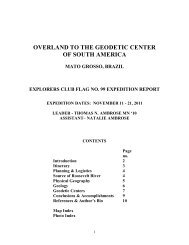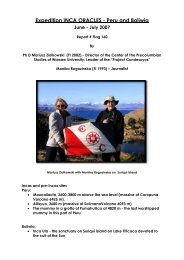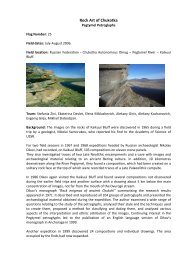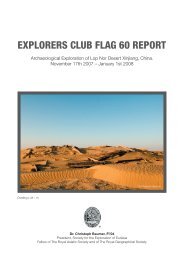the explorers journal the global adventure issue - The Explorers Club
the explorers journal the global adventure issue - The Explorers Club
the explorers journal the global adventure issue - The Explorers Club
- No tags were found...
You also want an ePaper? Increase the reach of your titles
YUMPU automatically turns print PDFs into web optimized ePapers that Google loves.
fields and rugged icepackin uncharted territory. Forinformation, visit: www.beyondshackleton.com.Brightest SupernovaEver Spottedis one coming to a galaxy near you?<strong>The</strong> brightest stellar explosionever recorded may be a longsoughttype of supernova,according to observationsby NASA’s Earth-orbitingChandra X-ray Observatoryand ground-based opticaltelescopes in Hawaii. Thisdiscovery indicates that violentexplosions of extremelymassive stars were relativelycommon in <strong>the</strong> early universe,and that a similar explosionmay be ready to go off in ourown galaxy.“This was a truly monstrousexplosion, a hundred timesmore energetic than a typicalsupernova,” said NathanSmith of <strong>the</strong> University ofCalifornia at Berkeley, who leda team of astronomers fromCalifornia and <strong>the</strong> Universityof Texas in Austin.First detected in September2006, <strong>the</strong> SN 2006gy explosionoccurred in a galaxyknown as NGC 1260, some240 million light-years away.It brightened over <strong>the</strong> course10EXPLORATION NEWSof 70 days, and at its peakemitted more than 150-billion-Sun’s worth of light.Scientists estimate thatamong <strong>the</strong> 400 billion starsin <strong>the</strong> Milky Way, <strong>the</strong>re areonly a dozen or so as massiveas SN 2006gy. <strong>The</strong> star thatproduced SN 2006gy apparentlyexpelled a large amountof mass prior to exploding.This large mass loss issimilar to that seen from EtaCarinae, a massive star 7,500light-years away in our owngalaxy, raising suspicion thatit may be poised to explodeas a supernova. An unstablestar, Eta Carinae is currentlyradiating about five milliontimes more energy than ourSun and is undergoing eruptionson its surface that aresimilar to what scientiststhink happened on <strong>the</strong> starthat produced SN 2006gyjust before it blew.“Eta Carinae’s explosioncould be <strong>the</strong> best star-showin <strong>the</strong> history of modern civilization,”said Mario Livio of <strong>the</strong>Space Telescope ScienceInstitute in Baltimore,” notingthat despite its relativelyclose proximity to us, EtaCarinae’s death is not likelyto pose any significant threatto life on Earth.Scientists believe thatafter <strong>the</strong> violent collapse ofstars such as SN 2006gy,runaway <strong>the</strong>rmonuclear reactionsensue and <strong>the</strong> explodingstars spew <strong>the</strong>ir remains intospace ra<strong>the</strong>r than completelycollapsing to a black hole as<strong>the</strong>orized. “In terms of <strong>the</strong>effect on <strong>the</strong> early universe,<strong>the</strong>re’s a huge difference between<strong>the</strong>se two scenarios,”said Smith. “One pollutes<strong>the</strong> galaxy with large quantitiesof newly made elementsand <strong>the</strong> o<strong>the</strong>r locks <strong>the</strong>mup forever in a black hole.”Information and images of <strong>the</strong>supernova are available at:http://chandra.nasa.govSo What’s in a Comet?not <strong>the</strong> kitchen sink<strong>The</strong> heart of comet Tempel-1,which spurted out some ofits contents during <strong>the</strong> DeepImpact spacecraft encounterin July 2005, contains amixture of materials usuallyfound in very different environments,scientists report.Carey M. Lisse of JohnsHopkins University AppliedPhysics Laboratory in Laurel,MD, and colleagues traced<strong>the</strong> mineral compositionof <strong>the</strong> ejecta from infraredspectra taken with <strong>the</strong>Spitzer Space Telescope.<strong>The</strong> mixture included highlyvolatile organic ices, clays,and carbonates formed inenvironments with waterpresent, and highly crystallinesilicates formed at temperaturesexceeding 1,000degrees Kelvin. “Some typeof <strong>global</strong> mechanism formixing <strong>the</strong>se materials musthave been available during<strong>the</strong> solar system’s earliestdays,” says Lisse.
















